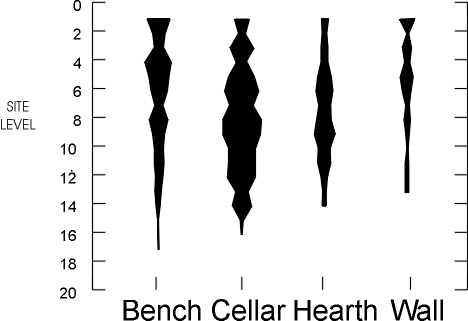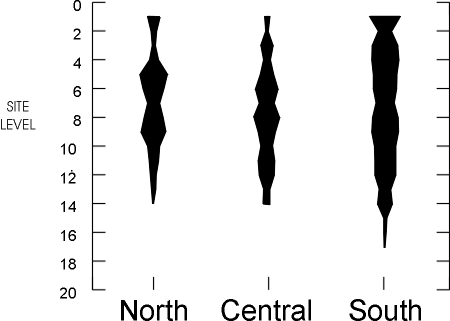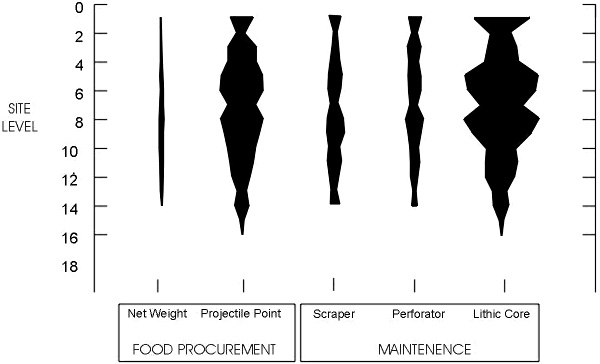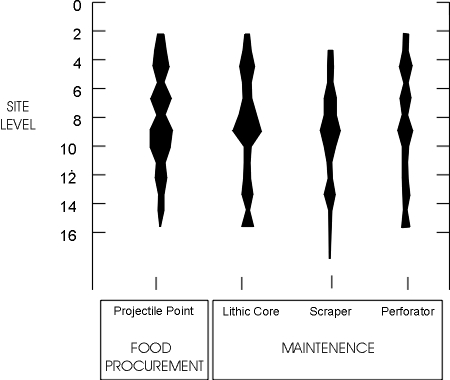
There are a number of questions about site-formation at Meier that may be investigated with the use of seriation, or more accurately, an examination of artifact frequency through time, manifest as frequency by excavation depth, without the concern with style typically associated with seriation studies.
Here I report on some methods, questions and results from recent seriation studies of the Meier Site assemblage.
Seriation Procedure
Seriation basically displays the frequency of artifacts through time by plotting artifact frequencies per excavation level. At the Meier site, for a number of technical reasons, elevations of excavation unit levels were not uniform; unit A, for example, may have a level 2 extending from 30-50 cm below site datum (BSD) while level B's level 2 may have extended from 42-51 cm BSD. Because seriation displays frequency per level, a seriation using field excavation levels would erroneously display high frequencies simply where many excavation units had the same upper and lower level elevations, and similarly misleading lower frequencies where there were only several (or one) excavation unit with given upper and lower level elevations.
For this reason, the first objective was to develop 'Site Levels' which assigned each artifact to a level which subsumed all site excavation levels in a generic scheme. Ten-centimeter increments were chosen because most artifacts could be assigned to 10cm levels. Artifacts were assigned to Site Levels based on thier 'average elevation'. Average elevation was computed as the average of the lower and upper excavation level elevations. For example, an artifact found in some unit's level 3, extending from 46-58cmBSD, would be assigned to 52cmBSD (52 being the average of 46 and 58). Following this, the artifact would be assigned to Site Level 6, which contains all artifacts encountered from 51 to 60cmBSD. As noted above, the development of Site Levels makes it possible to examine artifact frequency by uniform excavation depth; these levels must be remembered as arbirtrary time units, though useful in that they order the artifacts relative to one another, providing a database suitable for seriation.
The Law of Superposition at the Meier Site
At the Meier site, excavation depth may or may not be a good surrogate for the relative date of artifact deposition; this is because in some areas, the cellar pits in particular, matrix was periodically dug out by the plankhouse inhabitants during maintenence activities. This is evidenced in stratigraphic profiles which show repeated cutting of pits into older, filled pits. Nevertheless, some of the pits lower in the excavations were filled and do represent earlier deposits. Part of the focus of this study (see below) is to evaluate the degree to which we may consider pit-associated items older, if deeper.
Other areas of the plankhouse interior, however, were not so heavily reworked and maintained, and should provide some useful seriation data. The bench areas, for example, show little or no signs of architectural maintenence, in terms of digging or buttessing. For this reason, bench deposits may contain useful chronological data. The problem with the bench deposits is that they generally contain low frequencies of artifacts, and we have demonstrated elsewhere that most of the utilitarian artifacts which comprise the bulk of the Meier assemblage were stored in the cellars or adjacent, near the hearths. We suspect that the bench areas probably contained artifacts, such as personal posessions, which were largely removed from the site at abandonment; the general lack of status and ornamental goods at the site suggests a planned abandonment of the structure (Stephenson 1991).
Perhaps the best deposits within the plankhouse, for tracking artifact use through time, is the hearth area. Here, large numbers of artifacts were used, stored and lost in a busy, high-traffic area of the plankhouse interior which provided both light and warmth. Stratigraphically, the hearth and hearth periphery deposits are rather uniformly 'stacked'. This indicates a sort of continuity in the architecture of the plankhouse interior through time (that is, the central area of the house was assigned to be the hearth area from the beginning, and this did not vary with time). There is little re-working of the deposits peripheral to the hearth boxes proper, providing us with a small area in which artifacts accumulated through time in a chronological sequence, more generally following the laws of superposition than the cellar deposits.
Artifacts found in or immediately adjacent to wall trenches were assigned to the 'wall' facility. Here, we may expect only little continuity of depsition with time, as features indicate that wall supports were occasionally re-set. Still, the walls were not moved radically and often, and some time-sensitive information may be available in these deposits.
The best time-sensitive deposits, of course, are found in the midden adjacent to and associated with the plankhouse. Analysis of the midden stratigraphy, artifacts and features indicates that it developed slowly as a layered accumulation of debris. Much of the midden debris appears to be 'dump' from the pits which form the plankhouse cellar; hearth clean-out episodes are also recorded in the midden in the form of dumped, disintegrated hearth-matrix features. In the midden, then, the law of superposition may generally be invoked to understand activities at the Meier Site. Of course, rank-related information is not preserved in the midden, but a number of important site-formation questions may be answered by analysis of midden seriation; these questions requre clarification before spatial distributions in the plankhouse may be examined. The most important question here is that of the temporal nature of production activity at Meier; were there important changes in activity, through time, that would generate material correlates which must be considered in spatial analyses of the site? For example, did the arrival of Europeans in the late (1700's) effect activities, such that the we must consider this when considering rank-specific production at Meier? This question is evaluated in this report with a number of discussions of Meier artifact seriation.
Research Questions and Seriation Data Types
Note that for printing, all figures are at the bottom of this document: because of page break problems, howevery, you may want to print after loading the image by clicking on the Figure number.Question 1. Are there radical differences in the nature of artifact load through time in the bench, cellar, hearth/periphery facilities (and the wall deposits) in the plankhouse? May we reasonably use seriation at Meier, and if so, is seriation best observed in particular architectural facilities? To test this, I seriated the entire plankhouse artifact assemblage by plankhouse facility (Bench, Cellar, Hearth/Periphery, and Wall deposits). The result is seen in Figure 1 (n=8,552 items of all types in the plankhouse and assignable to a given facility or wall trench area).
Question 2. Are there radical changes in the use of space within the plankhouse, through time, such that assemblages of the North, Central and South areas of the plankhouse may not represent the entire 400-year occupation in each of these zones? To test this, I seriated the entire plankhouse artifact assemblage by plankhouse zone (North, Central and South). The result is seen in Figure 2 (n=10,104 antler, bone and lithic artifacts excavated from within the plankhouse).
Question 3. Are there radical changes in the activities carried out in the plankhouse, through time, such that we may NOT assume the assemblage to represent a palimpsest of time-redundant activity? To test this, I seriated 1,754 of the most common functional artifact classes excavated from within the plankhouse. These were lithic cores (representing the general production of stone tools), lithic and bone or antler perforators and scrapers (representing common maintenence activities) and stone projectile points and net weights (representing common food-getting activities). The results are seen in Figure 3.
Question 4. This question is the same as 3, but here I examine the midden assemblage to search for change of activities through time. The midden, of course, is less likely to have been disturbed, and provides the finest chronological control at Meier. Evaluating whether the general trends seen in the plankhouse are reflected in the midden is an important goal here. For this test, I seriated the same set of artifacts as in test 3 (with the exception of net weights, which were not found in the midden). This seriation used 456 artifacts. The results are seen in Figure 4.
Discussion
Note that in the following discussion, I am mostly concerned with site-formation
processes; therefore, I limit my comments on what may account for some
of the expansions and contractions of the various seriation graphs.
Such a study would be fascinating but is beyond the scope of this report.
Here I am concerned with a limited set of questions (noted above and below)
and I constrain my obervations to
very specific phenomena which should inform on these questions.
Test 1.
My first question is ‘Can we reasonably use seriation in the Meier plankhouse, given what we know about architectural maintenance and its effects on vertical distributions?’ To evaluate this question, I seriated the entire artifact assemblage by architectural facility.
The nature of the Bench, Cellar, Hearth/Periphery and Wall deposits, as presently understood from artifact and feature analysis, was described above. The point here is to compare expectations with observations.
Figure 1 indicates that, as expected, the Bench facilities gradually accrued a load of artifacts through time. There is little to suggest periodic cleaning, which should appear as radical fluctuations of artifact loads, or possibly even stratigraphic breaks. Rather, as mentioned, we see a general increase in material culture through time. A distinct contraction is seen at Site Level 7, as in all other facilities; this may represent a significant occupational hiatus or population change, but what is most important the present question is that the contraction is seen in all facilities; the implications of this are discussed below under Test 2, but may be summarized as follows: some form of temporal record is evidenced across all facilities, manifest in the contraction at Site Level 7, followed by an increase after Site Level 7, as well as a conspicuous expansion of frequencies after Site Level 2. The fact that these phenomena, whatever their causes, are evidenced equally across architectural facilities suggests that seriation may reasonably be carried out at Meier if appropriate analytical cautions are taken.
The Cellar facility displays the most radical fluctuations of artifact load, possbily reflecting the continual ‘clean-out / artifact loading / clean-out’ maintenance schedule evidenced for the Meier pit features. As noted, however, some lower pits do contain older items, as the re-excavation of pit by the Meier people did not always remove all previous pit contents. Artifacts from the cellars will have to be evauated on an individual basis, in terms of pit chronology. Where cellar artifacts are not associated with distinct pits, it will remain difficult to identify their temporal status. Nevertheless, cellar artifacts may be referrable to new analytical levels, such as ‘pre-Level 7 contraction’. Further thought is needed on this topic.
The Hearth area displays moderately low frequencies of artifacts, and does not exhibit the general increase in material culture seen in the Bench facility. This may be because the hearth perpphery was a high-traffic area that was more commonly cleaned, with artifacts normally being stored in the adjacent cellars. Again, as in the Bench, Cellar and Hearth, we do not see any radical stratigraphic break, but a general continuum of artifact presence, recording behaviour of the plankhouse inhabitants, over time. We also see that the Site Level 7 contraction is evident in the Hearth area, with the implications discussed above.
Artifacts from the wall trenches most closely follo the pattern seen in the Bench facility: a general increase of material culture through time, with few significant constrictions and, as in all cases so far, a rather abrupt termination of material culture loads at Site Level 1 (the implications of this termination for site-abandonment conditions are discussed in Test 2, below).
What is most evident from Test 1 is that there are no radical ‘breaks’ in the temporal sequences, and artifacts did generally increase in number with time. The status of artifacts from the cellar is still questionable, in terms of fine-grained chronology, but it may be able to divide the cellar deposits into gross pre-and post-contact levels based on such site-wide phenomena as the ‘Site Level 7’ contraction. The Bench facility, however, appears to be the best place to observe artifact change through time, followed by the Hearth area, where in both places we see most what we would expect. I conclude that we can in fact carry out seriation at Meier, because in these deposits we do not see radical ‘stratigraphic breaks’ or other unusual phenomena.
Test 2.
What is the temporal nature of the deposits in the North, Central and South areas of the plankhouse? Were different areas used at different times, and must we consider differences in spatial distributions as potentially related to differential use of the plankhouse interior through time?
Figure 2 indicates that each plankhouse zone was used from the earliest to the latest periods. All areas appear to have been 'settled' and 'abandoned' at the same times; there do not appear to be stratigraphic breaks which would indicate complete abandonment of the plankhouse for appreciable time periods.
There appears to be a slight, general reduction of artifact loads towards the end of the occupation, which suggests a shrinking population. Nevertheless, rather average frequencies of artifacts are found at the final period of occupation, suggesting that although the population was low, and activity was somewhat lower than at some time in the past, the plankhouse was abandoned while the normal activities of life were underway. There does appear to be a general increase, through time, in material culture; this may reflect growth of the plankhouse population, but explanations of this nature are beyond the scope of this report and will require more careful analysis.
These observations are consistent with the feature data which suggest that the plankhouse was built as a single structure and, although modifications were occasionally made, this structure was maintained as an integrated, functional entity through its 400-year occupation.
In comparing the three zones, we see that in the South there is a general increase of artifact frequency through time. There follow some minor contractions and expansions, and an abrupt end to the material culture load, with the implications noted above. Conspicuous reductions or low artifact loads occur at Site Levels 2 and 7, uniformly across the South, Central and North zones. Here I do not consider the reasons for these pheonomena, but I do note that they are found uniformly in all zones of the plankhouse. This suggests to me that the plankhouse interior ‘floor’ was of an even elevation throughout occupation, being effected simultaneously in all zones by whatever reduction of activity and/or population the contractions represent. So, as much as we may consider ‘deeper=older’ at Meier, we may say that this general law applies to all areas of the plankhouse.
Comparing the general shape of the three zones, we see some clear differences; there are more artifacts, in generalm in the South than in the North and Central areas, and the North (in particular) and the Central areas’ artifact loads seem to fluctuate more than in the South. Following Site Level 5, in the North, there seems to be a rather radical reduction of material culture, followed by a slow replenishment towards a more average score at abandonment. Something similar is seen in the Central area. It will be necessary to examine the material culture from these upper levels to identify their general characteristics, and evaluate the effect of this phenomenon on spatial distributions. There is potential here for behavioural changes during occupation which may significantly effect spatial distributions of artifacts. It may be necessary to focus on lower, earlier materials when commenting on plankhouse activities in general, and it will be necessary to explain this phenomenon.
Tests 3 and 4.
Here the question is directly related to the analysis of production at the Meier site. If production changed radically at the site during some time in its history, and this were not accounted for, variations in certain tool types may result and be improperly interpreted. For this reason, it is important to establish the degree of activity continuity at the site.
In this initial test I examined several tools used in common maintenance and food-gathering activities; net weights, projectile points, scrapers, cores and perforators. I wanted to see whether, for example, net weights were not used until the very end of the occupation, or perforators were used only at the beginning, and later abandoned as activities at the site changed.
I looked at the seriations of these items in both the house and the midden. The midden examination was to provide a test of the reliability of the house data; if the same general trends were seen in the midden as in the house, the patterns observed in the house may be considered rather reliable. This is because the midden is assumed to be associated with the house (a proposition further evaluated by this examination) and should reflect, to an extent, what was occuring in the house.
What was most clear here is that all of these artifact types were used throughout the life of the household. From the very start, people were using scrapers, making lithic tools, perforating all variety of materials, hunting land animals, and fishing with net weights. These behaviours all continued until abandonment of the plankhouse (under the conditions suggested above in Test 2). Also very clear is the fact that, in general, the midden records both the increase in material culture through time and the occasional reductions in activity. Despite topography and the dome-like shape of the midden, it may be possible to correlate increases and decreases in the artifact loads in house levels with those in the midden, by using classic seriation techique across a variety of artifact types; a project for someone else, however.
Much may be said about these observations , but for the moment my concern is with the general concordance between the midden and house assemblages both in terms of the continuity of activity through time. Before analysis, each artifact type to be examined from Meier will be evaluated for its ‘temporal profile’, so that if certain activities were time-sensitive, they will be ideintified. I suspect, however, that most of the mundane, production-related activities I am researching (e.g. woodworking, antler-carving, and so on) will be as we see in scrapers, perforators and points; continuous through time. The spatial analysis of production, then, can be fortified on the grounds that it is not, at least, erroneously observing and interpreting time-sensitive activities.
Conclusions
It is important not to reify the Site Levels observed in this report; they must be rememberd to be arbitrary, 10cm increments. At the same time, however, it is clear that some temporal information is preserved at Meier, in particular in the Midden. This is suggested because a number of expectations of a ‘proper’ seriation are confirmed, both in the plankhouse and in the midden, including a general increase in material culture frequency through time from low or moderate initial scores. Counter to what I have thought for some time, the plankhouse interior, also, should not be ‘written off’ in terms of temporal control; significant and meaningful temporal data appear to be available in bench, cellar and hearth deposits.
Caution will be required, but it seems possible to evaluate some basic temporal issues at Meier. In particular, I feel that with care it will be possible to identify pre- and post-contact deposits, so that activity in the plankhouse during these two most important periods may be compared. During this examination of the seriations I examined the distribution of glass items, as a marker of the contact period, in the midden. I found that glass was present deep in the midden, but on careful examination, all 8 pieces of glass below 60cm BSD were found to be intrusive and clearly the result of pothunter activity. By examining level forms I determied that inmy opinion, the first definite, in-situ piece of glass in the Meier midden appears at roughly 60cmBSD. This places it in Site Level 5, roughly equal to Site Level 5 in the plankhouse. It may be that in some contexts (e.g. the hearth and bench areas) this level may be considered the first level of postcontact material; this may aid a great deal in understanding the site and investigating pre- and post-contact activities.
With respect to spatial distribution analysis, it appears that my current mode of considering the plankhouse assemblage to represent a 400-year palimpsest is, generally, valid. Although there are some important time-dependent artifact frequency fluctuations to investigate, there appears to be a general temporal continuity in the most common production activities; scrapers, for example, were used throughout occupation, as were perforators and net weights. The most cautious approach will be to consider each ‘temporal profile’ of each artifact tyoe before commenting on spatial distributions. This will not be as laborious as it sounds, however, as only roughly 15 functional types will be evaluated in the usewear study, not the entire range of 142 extant artifact types. Although it will probably be rare, it will be critical to know if a certain artifact type (e.g. hide scraper, antler graver) appears for example, at a certain time, and disappears abruptly shortly thereafter. Such evaluations will be easy and rapid with the database in its current condition.

Figure 1. Seriation of Artifacts by
Site Level and Architectural Facility.
Data are counts of 8,552 artifacts of all types.

Figure 2. Seriation of Artifacts by
Site Level and Plankhouse Zone.
Data are counts of 10,104 artifacts of all types.

Figure 3. Seriation of Artifacts by Function
in the Plankhouse.
Data are counts of 1,754 artifacts of types indicated.

Figure 4. Seriation of Artifacts by Function
in the Midden.
Data are counts of 456 artifacts of types indicated.
Return to Cameron's Home Page